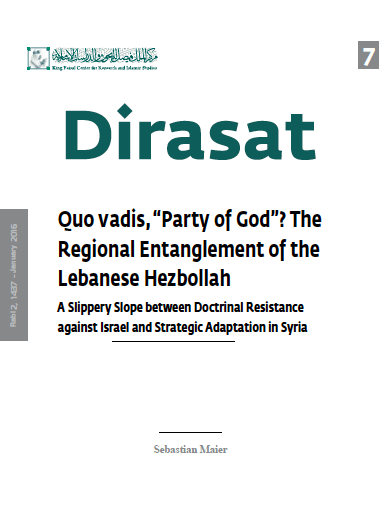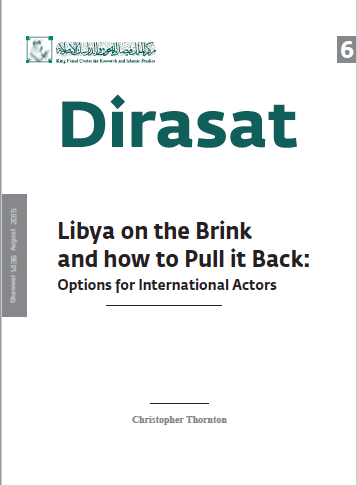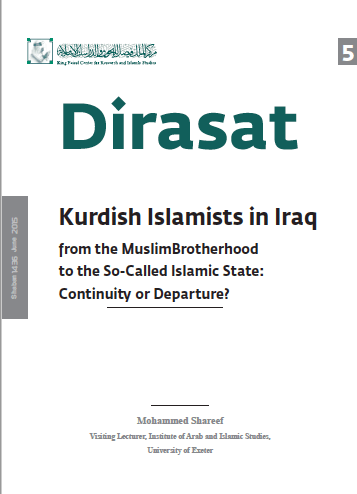Dirasat (KFCRIS Papers)
Number:
Author:
This analysis strives to factually present the evolution of Germany’s foreign and security policy vis-à-vis the Syrian Arab Republic and the Republic of Iraq. It assesses the question of whether German foreign policy is guided by a new doctrine, insofar as it envisages to assume more security policy responsibility on the global stage, as stated in the recently published “2016 White Paper on German Security Policy and the Future of the Bundeswehr.”
Number:
Author:
By: Hyeju Jeong, Duke University History Department
While the Chinese Muslim diaspora population in Saudi Arabia is smaller than the diaspora populations of South Asia, Central Asia or Southeast Asia, whose historical ties with the coasts of the Red Sea are known to have left enduring vestiges in and around Mecca, Chinese Muslim communities have forged their own enclaves in the Hijaz and beyond for the past century or so, making permanent homes in different parts of the Kingdom. Journeying from various parts of China, they arrived i
Number:
Author:
In this paper Dr. Dania Kolielat ElKhatib discusses generally the elements needed to start a lobby as well as the tools needed to build it. It is written with an Arab Gulf audience in mind. The paper gives a general overview on lobbying, on the Arab American community and its organisations, on the narratives through which Arab states can engage them, and on the structure needed to create the type of coordination among different Arab American groups which will ultimately result in a “lobby.”
The paper consults literature on the history and methods of lobbying and does not by any means represent a concrete
Number:
Author:
English Translation Currently Unavailable
Number:
Author:
Pundits have long debated France’s Arab policy, which was launched by Charles de Gaulle and was seen as France’s “third way” between the two main powers of the Cold War era. is foreign policy explained France’s unique approach to the Palestinian ques- tion – which was, for decades, the only controversial issue in the Middle East – and then to the con ict in Lebanon, especially dur- ing the Civil War from 1975 to 1990.
Number:
Author:
This study attempts to analyze a major facet of the international struggle against Da’ish: its media war, which the organization wages alongside its efforts to expand and to fight surrounding regional and international powers. The study observes Da’ish’s media phenomena in the context of the integral role of the media in modern international conflicts, with attention to the development of media tools in Jihadist organizations since the seventies. This investigation reveals the remarkable evolution of the terrorist group in its bid to entrench itself as a caliphate state. The study focuses on Da’ish’s media administration structure and its strategy in deployin

Number:
Author:
Quo vadis, “Party of God”? The Regional Entanglement of the Lebanese Hezbollah: A Slippery Slope between Doctrinal Resistance against Israel and Strategic Adaptation in Syria. By, Sebastian Maier.
Published: Rabi 2, 1437 – January, 2016.
In this 7th version of Dirasat, Sebastian Maier argues:
While the Lebanese Hezbollah&r

Number:
Author:
Libya on the Brink and How to Pull it Back: Options for International Actors
Christopher Thornton
Shawwal 1436 August 2015
Abstract:
The launch of Operation Dignity in May 2014 transformed Libya’s low-level military and political conflict into a full-blown war. The seizure of Tripoli and much of western Libya by the opposing Libya Dawn movement left the country divided in two with two parliaments, two governments, and two putative armies

Number:
Author:
?Kurdish Islamists in Iraq, from the Muslim Brotherhood to the so-called “Islamic State:” Continuity or Departure
Mohammed Shareef
Issue 5 – Shaban 1436 June 2015
Abstract:
The major Islamist groups in the Kurdistan region of Iraq have long been part of the political landscape both at the subnational Kurdistan level and at the Iraqi national level. They gradually emerged in the late 1980s and became mo



